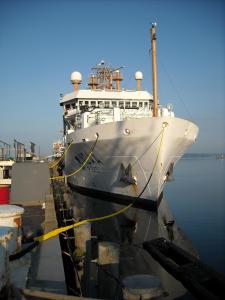At 0845 on a calm and sunny Thursday morning, 31 May 2012, the Fisheries Research Vessel Henry Bigelow quietly slipped its lines and left Pier 2 at the Newport Naval Station in Rhode Island, to steam out of Narragansett Bay. This marked the start of a fifteen-day Ecosystem Monitoring Survey covering the northeast continental shelf from North Carolina to Nova Scotia and Georges Bank.

The Henry Bigelow docked at Pier 2 Newport Naval Station on the morning of sailing. (Photo credit: Jerry Prezioso, NEFSC/NOAA)
Our mission includes multiple objectives: studying the abundance and distribution of plankton that form the base of the food chain for numerous species of fish, as well as looking for larval and juvenile forms of commercially valuable fish. We are also monitoring the oceanography that affects these planktonic populations. In addition, this ship is equipped with a system to continuously monitor the carbon dioxide and acidity levels of the water we are sailing through, an issue of concern that affects almost every marine form of life.
The ship began working on an inshore line of stations to skirt the remnants of Tropical Depression Beryl where some offshore work had originally been planned. The pace was pretty intense as the command, crew and scientists worked together to tow three different sets of sampling gear at each of the first four stations. The first stations of a cruise are always exciting as equipment gets put to the test, along with people’s patience when things don’t work as planned! It isn’t long however before everyone settles into a routine, repairs are made and things progress more smoothly.
Now, in the wee hours of Saturday morning, every piece of equipment has been used and tested, so we are fully operational. Our initial gear comparison stations yielded some interesting results but not the hoped-for flounder larvae we were seeking. We did however have some catches of what look like juvenile hake in the two and one half to five centimeter range, as well as some eel larvae that were about ten to twelve centimeters long. These catches were made south of Long Island. Currently we are working off the New Jersey coast, heading south to get our Mid-Atlantic Bight stations sampled. The weather has been pretty good for the most part, although we did see some lightning in the distance while en route to this latest station and it is raining steadily right now. Winds aren’t too bad, and this ship is making excellent time between stations, so our chances for surveying the entire area we have planned look pretty good right now.
Jerry Prezioso
Chief Scientist
HB 12-02 Ecosystem Monitoring Survey
